Unit 4 Protecting our heritage sites 课件 -2024-2025学年高中《英语》 选择性必修 第三册(译林版)
文档属性
| 名称 | Unit 4 Protecting our heritage sites 课件 -2024-2025学年高中《英语》 选择性必修 第三册(译林版) | 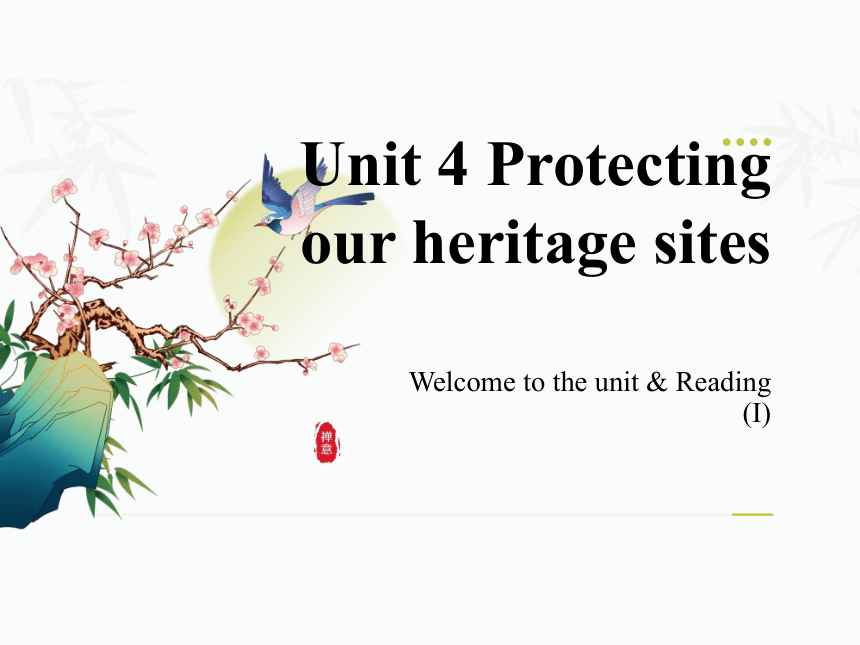 | |
| 格式 | pptx | ||
| 文件大小 | 4.0MB | ||
| 资源类型 | 试卷 | ||
| 版本资源 | 牛津译林版(2019) | ||
| 科目 | 英语 | ||
| 更新时间 | 2025-01-05 18:16:23 | ||
图片预览

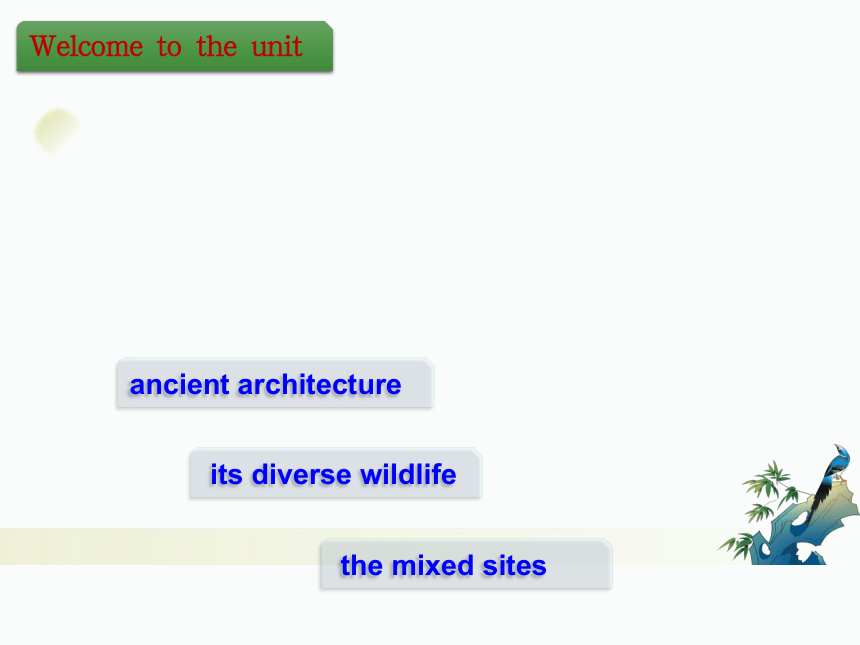
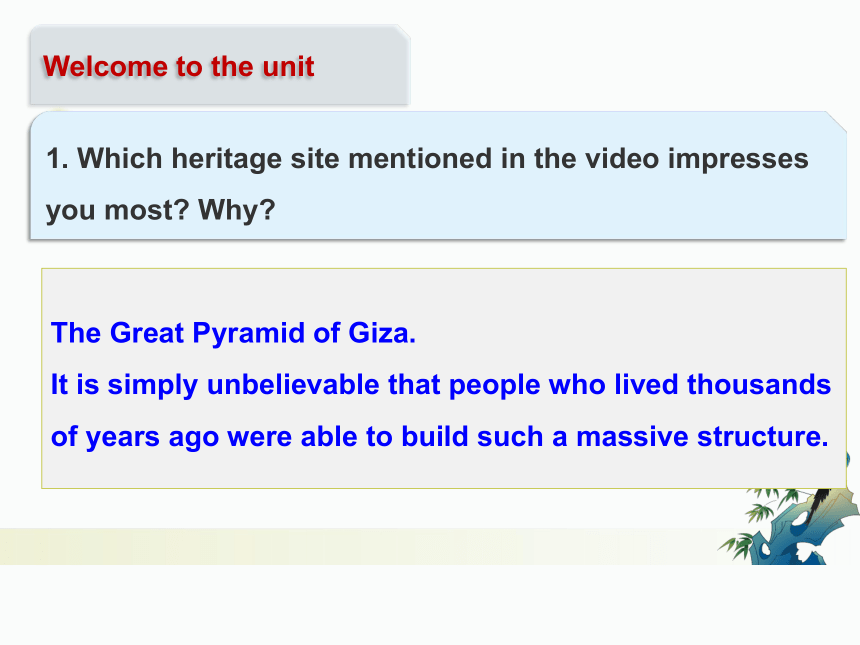
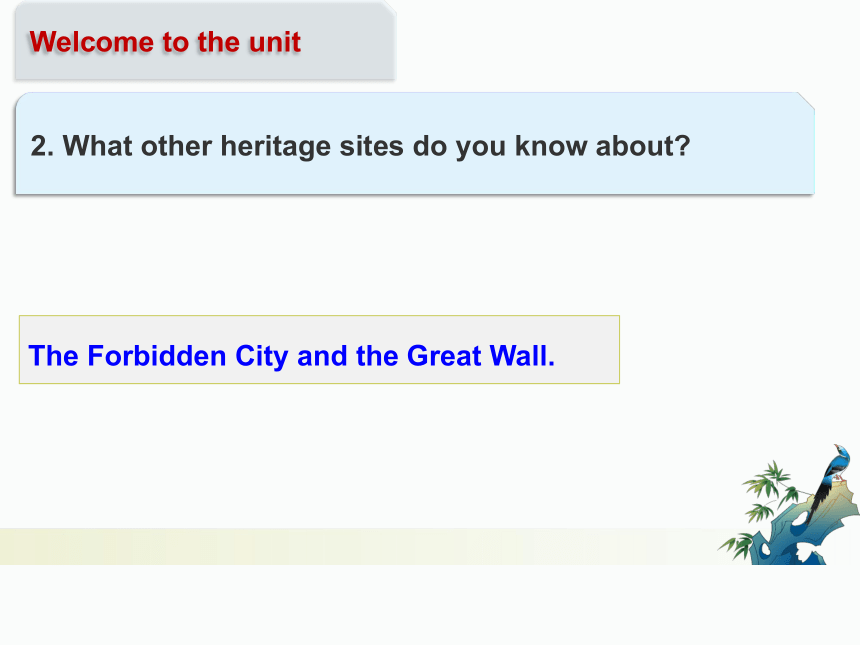
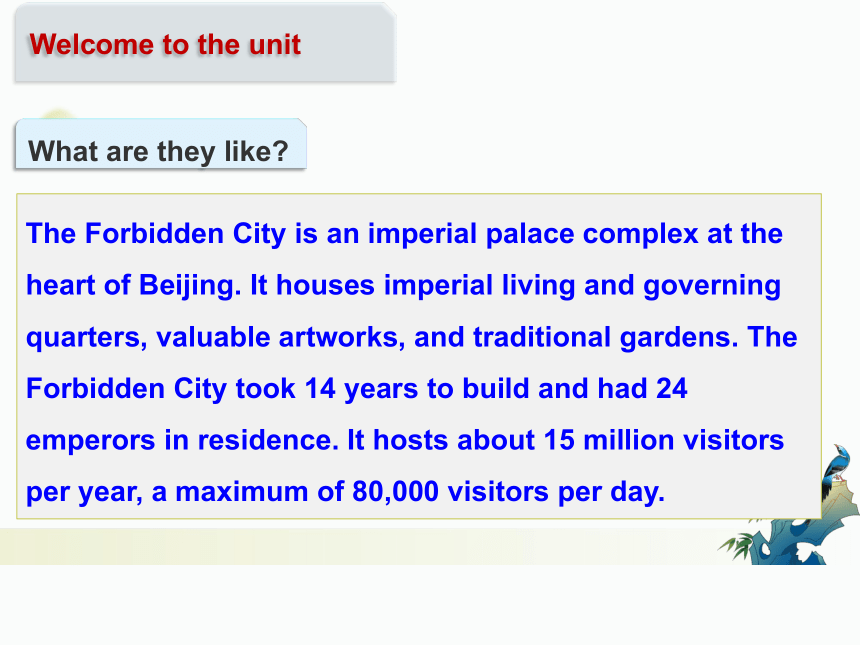
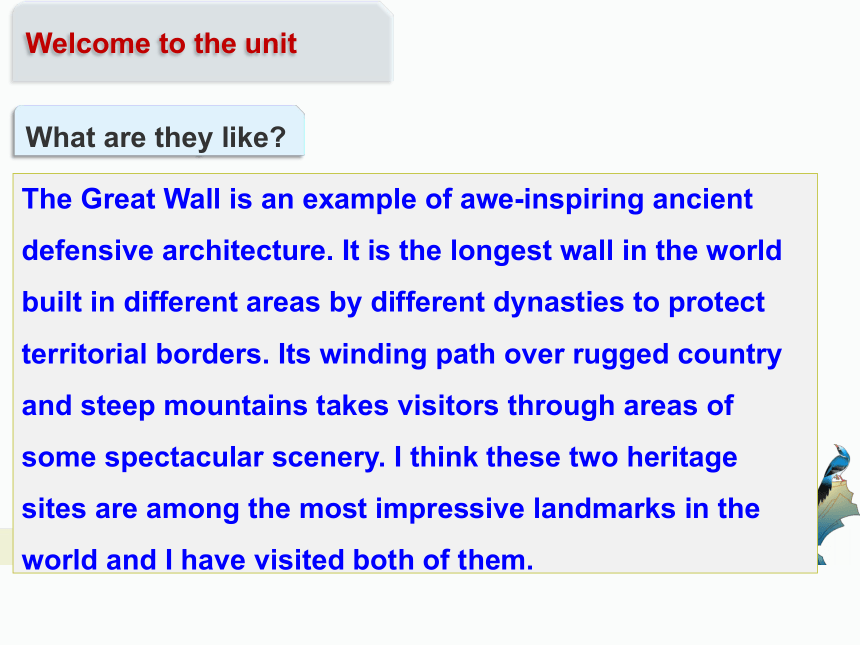
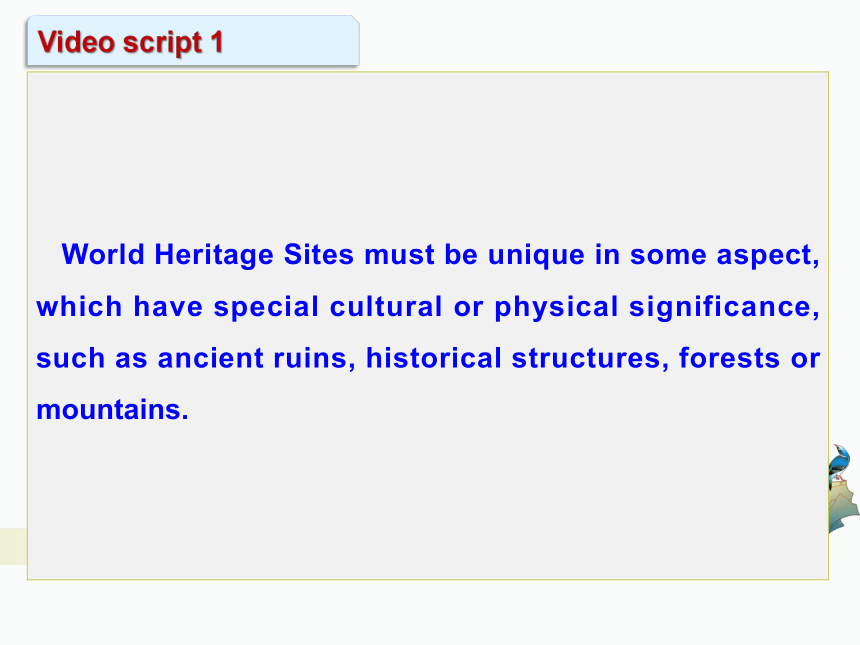
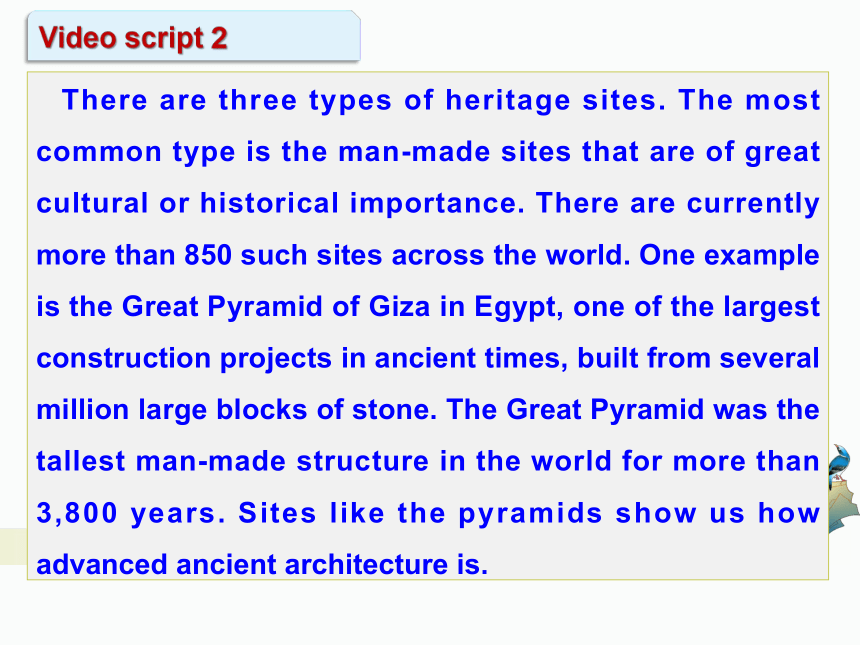

文档简介
(共29张PPT)
Welcome to the unit & Reading (I)
Unit 4 Protecting our heritage sites
Welcome to the unit
ancient architecture
its diverse wildlife
the mixed sites
1. Which heritage site mentioned in the video impresses you most Why
The Great Pyramid of Giza.
It is simply unbelievable that people who lived thousands of years ago were able to build such a massive structure.
Welcome to the unit
2. What other heritage sites do you know about
Welcome to the unit
The Forbidden City and the Great Wall.
The Forbidden City is an imperial palace complex at the heart of Beijing. It houses imperial living and governing quarters, valuable artworks, and traditional gardens. The Forbidden City took 14 years to build and had 24 emperors in residence. It hosts about 15 million visitors per year, a maximum of 80,000 visitors per day.
What are they like
Welcome to the unit
What are they like
The Great Wall is an example of awe-inspiring ancient defensive architecture. It is the longest wall in the world built in different areas by different dynasties to protect territorial borders. Its winding path over rugged country and steep mountains takes visitors through areas of some spectacular scenery. I think these two heritage sites are among the most impressive landmarks in the world and I have visited both of them.
Welcome to the unit
World Heritage Sites must be unique in some aspect, which have special cultural or physical significance, such as ancient ruins, historical structures, forests or mountains.
Video script 1
There are three types of heritage sites. The most common type is the man-made sites that are of great cultural or historical importance. There are currently more than 850 such sites across the world. One example is the Great Pyramid of Giza in Egypt, one of the largest construction projects in ancient times, built from several million large blocks of stone. The Great Pyramid was the tallest man-made structure in the world for more than 3,800 years. Sites like the pyramids show us how advanced ancient architecture is.
Video script 2
The second type is the sites of outstanding natural importance. Yellowstone National Park in the USA is one of these sites. In 1978, Yellowstone was named a UNESCO World Heritage Site. It’s the oldest national park in the USA, and perhaps the oldest in the world. With its diverse wildlife and many geothermal features, Yellowstone is treasured around the world. The park is famous for its spectacular volcanic geysers which shoot steaming water high into the air.
Video script 3
The third type is the mixed sites: the ones that are both cultural and natural. One example is Mount Huangshan in Anhui Province, China. Its towering peaks rise above a sea of clouds, making for breathtaking mountain scenery. Mount Huangshan has been the subject of countless paintings and poems.
Video script 4
In total, there are over 1,000 UNESCO World Heritage Sites, with new ones being added each year, and all of them are definitely worth visiting! In the light of the value of heritage, we should do our best to preserve the heritage sites.
Video script 5
What historic or natural sites are there in your area
I know of the Xiaoling Tomb of the Ming Dynasty, which is a UNESCO World Heritage Site. It is one of the biggest imperial tombs in China. It lies to the east of Nanjing at the southern foot of Purple Mountain. The tomb stands out not only because of the scale, but also for its unique design and beauty. Zhu Yuanzhang, the first emperor of the Ming Dynasty, and Empress Ma were buried there. It is extremely popular with tourists.
Warming up
What dangers do you think cultural and natural heritage sites are faced with
The dangers to cultural and natural heritage sites can come from both natural forces and man-made activities. Natural elements like water and wind can erode heritage sites over time. The history and beauty that these sites have carried for thousands or even millions of years can easily be lost. While human activities also present a danger to heritage sites, such as allowing too many tourists, human inaction in taking measures to protect and preserve these sites is just as harmful.
Warming up
(1) Heritage sites face various dangers.
(2) Sudden and powerful natural forces
(3) Flood of tourists
(4) Widespread development
(5) Heritage protection must be a combined effort.
A1
Answer
(1) Which is the best subtitle of para. 2 and para. 3
A. Heritage sites
B. Activities and heritage
C. Ruins of the pyramids
D. Dangers from man and nature
A1
Check
(2) How does the author mainly develop the lecture transcript
By using examples.
B. By using inference.
C. By using cause and effect.
D. By using assumption.
A1
Check
1. How many UNESCO heritage sites are there worldwide
There are currently around 1,100 sites.
A2
A2
2. How do wars threaten heritage sites
Wars can cause damage to ancient clay sculptures and buildings.
3. What activity is causing damage to the temples of Angkor
Thousands of tourists climbing up the narrow stone steps every day.
A2
4. Why is the Historic Centre of Vienna on the List of World Heritage in Danger
Because of high-rise construction projects in central Vienna.
A2
5. What causes the loss of the coral on the Great Barrier Reef
High seawater temperatures caused by global warming.
A2
(1) What can we know from the lecture transcript
A. Warm seawater temperatures destroy seas’ natural ecology.
B. Too much visiting does harm to the temples of Angkor.
C. A big earthquake destroyed the whole city of Bam in 2003.
D. Vienna has been recognized as the musical capital of the world.
A2
Check
(2) What does “so” refer to in the fifth sentence in para. 1
A. Natural wonders.
B. Human civilization.
C. Feeling amazed by human civilization and natural wonders.
D. Asking some questions about natural and human wonders.
A2
Check
The lecturer mentions examples of heritage sites facing dangers. Can you think of more examples
Example of natural disasters:
Everglades National Park is a natural heritage site in Florida, USA. Every year, destructive hurricanes damage or destroy the vulnerable wetlands that are home to a huge diversity of unique wildlife.
A3
Example of wars:
In the Democratic Republic of the Congo, armed conflict catches the wildlife in the crossfire and some rare species are endangered. The world’s smallest population of
mountain gorillas, which could become extinct in the near future due to other threats, sometimes also die in the war.
A3
The lecturer mentions examples of heritage sites facing dangers. Can you think of more examples
Example of tourist damage:
The world-famous Stonehenge in the UK is one of the most impressive prehistoric stone monuments in the world because of the size and shape of its stones, and its architectural design. It draws over 800,000 tourists annually. They have caused some damage to the prehistoric stones by chipping away at them.
A3
The lecturer mentions examples of heritage sites facing dangers. Can you think of more examples
At the end of the lecture, what questions would you like to ask the lecturer
How can countries where natural disasters occur frequently plan ahead to reduce the risks of their heritage sites getting damaged
Apart from relying on UNESCO and other authorities to protect heritage sites, what action can individuals take to help protect them
What efforts have been made to protect heritage sites
A3
Homework
Finish part A in the workbook.
感谢观看
thank you
Welcome to the unit & Reading (I)
Unit 4 Protecting our heritage sites
Welcome to the unit
ancient architecture
its diverse wildlife
the mixed sites
1. Which heritage site mentioned in the video impresses you most Why
The Great Pyramid of Giza.
It is simply unbelievable that people who lived thousands of years ago were able to build such a massive structure.
Welcome to the unit
2. What other heritage sites do you know about
Welcome to the unit
The Forbidden City and the Great Wall.
The Forbidden City is an imperial palace complex at the heart of Beijing. It houses imperial living and governing quarters, valuable artworks, and traditional gardens. The Forbidden City took 14 years to build and had 24 emperors in residence. It hosts about 15 million visitors per year, a maximum of 80,000 visitors per day.
What are they like
Welcome to the unit
What are they like
The Great Wall is an example of awe-inspiring ancient defensive architecture. It is the longest wall in the world built in different areas by different dynasties to protect territorial borders. Its winding path over rugged country and steep mountains takes visitors through areas of some spectacular scenery. I think these two heritage sites are among the most impressive landmarks in the world and I have visited both of them.
Welcome to the unit
World Heritage Sites must be unique in some aspect, which have special cultural or physical significance, such as ancient ruins, historical structures, forests or mountains.
Video script 1
There are three types of heritage sites. The most common type is the man-made sites that are of great cultural or historical importance. There are currently more than 850 such sites across the world. One example is the Great Pyramid of Giza in Egypt, one of the largest construction projects in ancient times, built from several million large blocks of stone. The Great Pyramid was the tallest man-made structure in the world for more than 3,800 years. Sites like the pyramids show us how advanced ancient architecture is.
Video script 2
The second type is the sites of outstanding natural importance. Yellowstone National Park in the USA is one of these sites. In 1978, Yellowstone was named a UNESCO World Heritage Site. It’s the oldest national park in the USA, and perhaps the oldest in the world. With its diverse wildlife and many geothermal features, Yellowstone is treasured around the world. The park is famous for its spectacular volcanic geysers which shoot steaming water high into the air.
Video script 3
The third type is the mixed sites: the ones that are both cultural and natural. One example is Mount Huangshan in Anhui Province, China. Its towering peaks rise above a sea of clouds, making for breathtaking mountain scenery. Mount Huangshan has been the subject of countless paintings and poems.
Video script 4
In total, there are over 1,000 UNESCO World Heritage Sites, with new ones being added each year, and all of them are definitely worth visiting! In the light of the value of heritage, we should do our best to preserve the heritage sites.
Video script 5
What historic or natural sites are there in your area
I know of the Xiaoling Tomb of the Ming Dynasty, which is a UNESCO World Heritage Site. It is one of the biggest imperial tombs in China. It lies to the east of Nanjing at the southern foot of Purple Mountain. The tomb stands out not only because of the scale, but also for its unique design and beauty. Zhu Yuanzhang, the first emperor of the Ming Dynasty, and Empress Ma were buried there. It is extremely popular with tourists.
Warming up
What dangers do you think cultural and natural heritage sites are faced with
The dangers to cultural and natural heritage sites can come from both natural forces and man-made activities. Natural elements like water and wind can erode heritage sites over time. The history and beauty that these sites have carried for thousands or even millions of years can easily be lost. While human activities also present a danger to heritage sites, such as allowing too many tourists, human inaction in taking measures to protect and preserve these sites is just as harmful.
Warming up
(1) Heritage sites face various dangers.
(2) Sudden and powerful natural forces
(3) Flood of tourists
(4) Widespread development
(5) Heritage protection must be a combined effort.
A1
Answer
(1) Which is the best subtitle of para. 2 and para. 3
A. Heritage sites
B. Activities and heritage
C. Ruins of the pyramids
D. Dangers from man and nature
A1
Check
(2) How does the author mainly develop the lecture transcript
By using examples.
B. By using inference.
C. By using cause and effect.
D. By using assumption.
A1
Check
1. How many UNESCO heritage sites are there worldwide
There are currently around 1,100 sites.
A2
A2
2. How do wars threaten heritage sites
Wars can cause damage to ancient clay sculptures and buildings.
3. What activity is causing damage to the temples of Angkor
Thousands of tourists climbing up the narrow stone steps every day.
A2
4. Why is the Historic Centre of Vienna on the List of World Heritage in Danger
Because of high-rise construction projects in central Vienna.
A2
5. What causes the loss of the coral on the Great Barrier Reef
High seawater temperatures caused by global warming.
A2
(1) What can we know from the lecture transcript
A. Warm seawater temperatures destroy seas’ natural ecology.
B. Too much visiting does harm to the temples of Angkor.
C. A big earthquake destroyed the whole city of Bam in 2003.
D. Vienna has been recognized as the musical capital of the world.
A2
Check
(2) What does “so” refer to in the fifth sentence in para. 1
A. Natural wonders.
B. Human civilization.
C. Feeling amazed by human civilization and natural wonders.
D. Asking some questions about natural and human wonders.
A2
Check
The lecturer mentions examples of heritage sites facing dangers. Can you think of more examples
Example of natural disasters:
Everglades National Park is a natural heritage site in Florida, USA. Every year, destructive hurricanes damage or destroy the vulnerable wetlands that are home to a huge diversity of unique wildlife.
A3
Example of wars:
In the Democratic Republic of the Congo, armed conflict catches the wildlife in the crossfire and some rare species are endangered. The world’s smallest population of
mountain gorillas, which could become extinct in the near future due to other threats, sometimes also die in the war.
A3
The lecturer mentions examples of heritage sites facing dangers. Can you think of more examples
Example of tourist damage:
The world-famous Stonehenge in the UK is one of the most impressive prehistoric stone monuments in the world because of the size and shape of its stones, and its architectural design. It draws over 800,000 tourists annually. They have caused some damage to the prehistoric stones by chipping away at them.
A3
The lecturer mentions examples of heritage sites facing dangers. Can you think of more examples
At the end of the lecture, what questions would you like to ask the lecturer
How can countries where natural disasters occur frequently plan ahead to reduce the risks of their heritage sites getting damaged
Apart from relying on UNESCO and other authorities to protect heritage sites, what action can individuals take to help protect them
What efforts have been made to protect heritage sites
A3
Homework
Finish part A in the workbook.
感谢观看
thank you
同课章节目录
